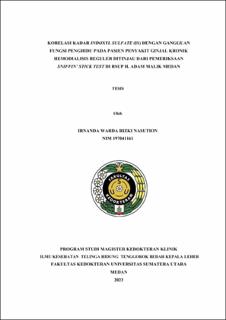Korelasi Kadar Indoxyl Sulfate (IS) dengan Gangguan Fungsi Penghidu pada Pasien Penyakit Ginjal Kronik Hemodialisis Reguler Ditinjau dari Pemeriksaan Sniffin’ Stick Test di RSUP H. Adam Malik Medan
Correlation Between Indoxyl Sulfate with Olfactory Dysfunction in Chronic Kidney Disease Patients

Date
2023Author
Nasution, Irnanda Warda Rizki
Advisor(s)
Munir, Delfitri
Haryuna, Tengku Siti Hajar
Metadata
Show full item recordAbstract
Background: High prevalence of olfactory dysfunction among chronic kidney disease (CKD) patients,
and the prevalence increased with the severity of kidney disease. Indoxyl sulfate (IS) is an aggressive
uremic toxin that accumulates significantly in the plasma of CKD patients. Olfactory damage may occur
in the setting of neuronal damage due to renal failure.
Methods: 27 patients with stage 5 chronic kidney disease on regular hemodyalisis who were examined
for indoxyl sulfate levels in blood plasma and then examined their olfactory function using the sniffin'
stick test consisting of odor threshold (T), discrimination (D) and identification (I) tests was carried out
in Haji Adam Malik General Hospital. A correlation test was applied between the results of indoxyl
sulfate levels and the results of olfactory function test in patients with CKD.
Results: Measured with the pearson correlation test showed that there was a strong significant negative
correlation between indoxyl sulfate values and olfactory function (r=-0.613; p=0.001) and a correlation
was obtained between the value of indoxyl sulfate and each component of the olfactory function,
threshold value (r= -0.408; p=0.035), discrimination (r= -0.807; p = 0.001) and identification (r= -0.703;
p=0.001).
Conclusions: Olfaction ability is impaired in patients with chronic renal failure and is associated with
the degree of accumulation of the uremic toxin indoxyl sulfate.
